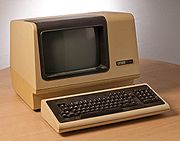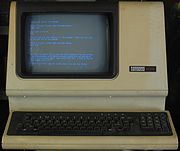
VT100
Encyclopedia

Computer terminal
A computer terminal is an electronic or electromechanical hardware device that is used for entering data into, and displaying data from, a computer or a computing system...
that was made by Digital Equipment Corporation
Digital Equipment Corporation
Digital Equipment Corporation was a major American company in the computer industry and a leading vendor of computer systems, software and peripherals from the 1960s to the 1990s...
(DEC). Its detailed attributes became the de facto standard
De facto standard
A de facto standard is a custom, convention, product, or system that has achieved a dominant position by public acceptance or market forces...
for terminal emulator
Terminal emulator
A terminal emulator, terminal application, term, or tty for short, is a program that emulates a video terminal within some other display architecture....
s.
History
It was introduced in August 1978, following its predecessor, the VT52VT52
The VT52 was a CRT-based computer terminal produced by Digital Equipment Corporation introduced in September, 1975 . It provided a screen of 24 rows and 80 columns of text and supported all 95 ASCII characters as well as 32 graphics characters. It supported asynchronous communication at baud rates...
, and communicated with its host
Server (computing)
In the context of client-server architecture, a server is a computer program running to serve the requests of other programs, the "clients". Thus, the "server" performs some computational task on behalf of "clients"...
system over serial lines using the ASCII
ASCII
The American Standard Code for Information Interchange is a character-encoding scheme based on the ordering of the English alphabet. ASCII codes represent text in computers, communications equipment, and other devices that use text...
character set and control sequences (a.k.a. escape sequence
Escape sequence
An escape sequence is a series of characters used to change the state of computers and their attached peripheral devices. These are also known as control sequences, reflecting their use in device control. Some control sequences are special characters that always have the same meaning...
s) standardized by ANSI
American National Standards Institute
The American National Standards Institute is a private non-profit organization that oversees the development of voluntary consensus standards for products, services, processes, systems, and personnel in the United States. The organization also coordinates U.S. standards with international...
. The VT100 was also the first Digital mass-market terminal to incorporate "graphic renditions" (blinking, bolding, reverse video
Reverse video
Reverse video is a computer display technique whereby the background and text colour values are inverted. On older computers, displays were usually configured to display white text on a black background by default. For emphasis, one swapped the color scheme to bright background with dark text...
, and underlining) as well as a selectable 80 or 132 column display. All setup of the VT100 was accomplished using interactive displays presented on the screen; the setup data was stored in non-volatile memory within the terminal. The VT100 also introduced an additional character set that allowed the drawing of on-screen forms.
The control sequences used by the VT100 family are based on the ANSI X3.64 standard, later ECMA
Ecma International
Ecma International is an international, private non-profit standards organization for information and communication systems. It acquired its name in 1994, when the European Computer Manufacturers Association changed its name to reflect the organization's global reach and activities...
-48 and ISO
International Organization for Standardization
The International Organization for Standardization , widely known as ISO, is an international standard-setting body composed of representatives from various national standards organizations. Founded on February 23, 1947, the organization promulgates worldwide proprietary, industrial and commercial...
/IEC
International Electrotechnical Commission
The International Electrotechnical Commission is a non-profit, non-governmental international standards organization that prepares and publishes International Standards for all electrical, electronic and related technologies – collectively known as "electrotechnology"...
6429. These are sometimes referred to as ANSI escape code
ANSI escape code
ANSI escape sequences are characters embedded in the text used to control formatting, color, and other output options on video text terminals. Almost all terminal emulators designed to show text output from a remote computer, and to show text output from local software, interpret at least some of...
s. The VT100 was not the first terminal to be based on X3.64—The Heath Company had a microprocessor-based video terminal, the Heathkit H-19 (H19), that implemented a subset of the standard proposed by ANSI in X3.64. In addition, the VT100 provided backwards compatibility for VT52 users, with support for the VT52 control sequences.
In 1983, the VT100 was replaced by the more-powerful VT200 series terminals such as the VT220
VT220
The VT220 was a terminal produced by Digital Equipment Corporation from 1983 to 1987.-Hardware:The VT220 improved on the earlier VT100 series of terminals with a redesigned keyboard, much smaller physical packaging, and a much faster microprocessor...
.
In August 1995 the terminal business of Digital was sold to Boundless Technologies.
Variants

Intel 8080
The Intel 8080 was the second 8-bit microprocessor designed and manufactured by Intel and was released in April 1974. It was an extended and enhanced variant of the earlier 8008 design, although without binary compatibility...
). Options could be added to the terminal to support an external printer, additional graphic renditions, and more memory (the "AVO" 'Advanced' Video Option — without this option, the VT100 could not display a full 24 lines of text when in 132 column mode). The VT100 became a platform on which Digital constructed related products.
The VT101 and VT102 were cost-reduced non-expandable follow-on products, with the VT102 including the AVO and serial printer port options of the VT100. The VT105 contained a simple graphics subsystem mostly-compatible with the earlier VT55. The VT125 added an implementation of the byte-efficient Remote Graphic Instruction Set (ReGIS
ReGIS
ReGIS, short for "Remote Graphic Instruction Set", was a vector graphics markup language developed by Digital Equipment Corporation for later models of their famous VT series of computer terminals. ReGIS supported rudimentary vector graphics consisting of lines, circular arcs, and text...
.) The VT103 included a backplane socket for an LSI-11 minicomputer
Minicomputer
A minicomputer is a class of multi-user computers that lies in the middle range of the computing spectrum, in between the largest multi-user systems and the smallest single-user systems...
board and supported dual TU58 DECtape
DECtape
DECtape, originally called "Microtape", was a magnetic tape data storage medium used with many Digital Equipment Corporation computers, including the PDP-6, PDP-8, LINC-8, PDP-10, PDP-11, PDP-12, and the PDP-15. On DEC's 32-bit systems, VAX/VMS support for it was implemented but did not become an...
II block addressable tape drive which behaved like a very slow disk drive. The VT180
VT180
The VT180 was a video terminal produced by Digital Equipment Corporation of Maynard, Massachusetts.An extension of their existing line of VT100 terminals, this version integrated a Z80 microprocessor and two external 5.25-inch floppy disk drives...
(codenamed "Robin") added a single-board microcomputer using a Zilog Z80
Zilog Z80
The Zilog Z80 is an 8-bit microprocessor designed by Zilog and sold from July 1976 onwards. It was widely used both in desktop and embedded computer designs as well as for military purposes...
to run CP/M
CP/M
CP/M was a mass-market operating system created for Intel 8080/85 based microcomputers by Gary Kildall of Digital Research, Inc...
. The VT278 added a built-in PDP-8
PDP-8
The 12-bit PDP-8 was the first successful commercial minicomputer, produced by Digital Equipment Corporation in the 1960s. DEC introduced it on 22 March 1965, and sold more than 50,000 systems, the most of any computer up to that date. It was the first widely sold computer in the DEC PDP series of...
processor, allowing the terminal to run Digital's WPS-8
WPS-8
WPS-8 was the name of a Word Processing System sold by Digital Equipment Corporation for use with their PDP-8 processors ....
word processing software.

